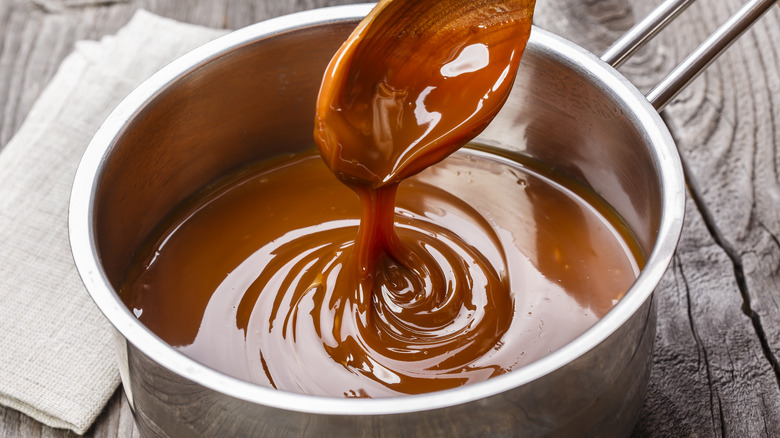What's The Difference Between Toffee And Caramel?
We may receive a commission on purchases made from links.
Caramel and toffee are two of the sweetest words in the English language. Both bring visions of delectable treats to mind: Shiny brittles studded with sumptuous nuts, individually wrapped candies that melt in the mouth, and decadent brownies drizzled with golden sauce. They're also both remarkably pure expressions of confectionery, typically consisting solely of sugar, water, and a simple dairy product like butter or cream. They even look alike: Both toffee and caramel come in delectable shades ranging from sunset orange to burnished bronze. Perhaps most strikingly, toffee and caramel tend to be paired with the same ingredients. Chocolate, sea salt, and nuts are all found in a myriad of toffee and caramel-based desserts.
These two sweets are so remarkably similar that it's easy to believe they've essentially the same thing. In fact, you might even understandably write the name difference off as a simple regional distinction, or assume one of them is a brand name, while the other is a generic term. But in fact, toffee and caramel are two distinctly different creations with unique properties, preparative processes, and absolutely scrumptious applications.
Making caramel and toffee
The biggest difference between toffee and caramel lies in the way they're made. While there are many different kinds of toffee, ranging from English toffee to bonfire toffee and honeycomb toffee, nearly all of them are hard candies. This pleasantly rigid texture comes from toffee's ingredients, and the unique way they're combined. According to MasterClass, toffee is made from sugar, water, and butter. These ingredients are cooked together in a spacious pot until the sugary mixture reaches the hard-crack stage. For those of you less up on your confectionery lingo, this means it hits a temperature of around 310 degrees Fahrenheit. As the name implies, this makes the candy hard, to the point that it cracks apart rather than pulling, melting, or otherwise squishily deforming.
Caramel, in contrast, is most often made with sugar, water, and cream. Other tasty elements, like the ever-popular sea salt of salted caramel treats, are often added as well. As with toffee, these ingredients are cooked in a large pot until the mixture reaches 240 degrees Fahrenheit, according to Encyclopedia Britannica. In candy-making, this is referred to as the soft-ball stage. This isn't a hard and fast rule, however: Caramel can also be heated to roughly 230 degrees, to create a velvety caramel sauce. However you cook it, it's bound to be delicious.
Toffee treats and caramel creations
The differences between toffee and caramel aren't entirely just about different ingredients and cooking temperatures. Once they're out of the pot and ready to be drizzled, dolloped, or enrobed, they're typically used to create remarkably different desserts. Notably, there's also a lot of overlap in what these tempting treats pair toffee or caramel with, but they still remain distinct. This comes down to differences in precise taste and texture between the two sweet substances.
Their unique textures are obvious, but you might think they taste largely the same, what with their similar ingredients. But in fact, the minor distinctions between them have a major impact on flavor. As you might expect, toffee has a delectably buttery taste, reminiscent of an excellent blondie. Caramel swaps this out for a deeply nutty flavor that comes from the cream's high lactose content. Toffee's buttery notes and crisp texture make it an excellent dance partner to chocolate. Heath candy bars, which cover rich toffee in milk chocolate, are one of the most famous examples of this perennial pairing. Toffee is also often paired with warm flavors like cardamom and nutmeg, as in chai spiced toffee.
Caramel's variable texture allows it a bit more freedom, while its rich flavor plays nicely with all sorts of different dishes. Caramel sauce can be draped over just about everything, but classic vanilla ice cream is a particularly popular choice: Its mellow flavor lets the caramel truly stand out. Fresh and fruity flavors also go wonderful with caramel, as is evidenced by the classic caramel apple.


